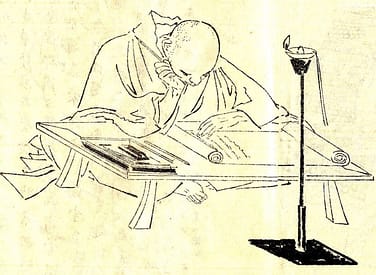Musings from Diane Durston, Curator Emerita
To sit alone in the lamplight with a book spread out before you and hold intimate converse with men of unseen generations—such is a pleasure beyond compare.
We certainly haven’t chosen the hermit’s life we are living today, but throughout history the solitary life provided the perfect way for some of Japan’s greatest writers to get at to the meaning of life.
One of these was Yoshida Kenko, a disillusioned Buddhist priest of 14th century Japan who left the chaotic political life in the imperial capital behind and retreated to a hut  in the woods, choosing instead to live the hermit’s life.
in the woods, choosing instead to live the hermit’s life.
Times were hard in 14th century Japan. Earthquakes and tsunamis wiped out whole cities. Civil wars destroyed much of the rest, and the great poets sought refuge in solitude, waiting for better days to come.
Alone with his thoughts, Kenko wrote Tsurezuregusa 徒然草, which was to become one of the great classics of Japanese literature. The title in English is Essays in Idleness, and it begins with the line that reads: “To while away the idle hours, seated the livelong day before the inkstone, by jotting down without order or purpose whatever trifling thoughts pass through my mind, truly this is a queer and crazy thing to do!”
Essays in Idleness is an example of a writing style called zuihitsu, following the brush. The writer just lets the mind and pen wander, jotting down thoughts and ideas, seemingly at random. Legend has it that this book was completed by one of Kenko’s followers who found notes pasted to the walls of Kenko’s cottage after his death and compiled them into a book of his thoughts and short essays on life and death and everything in between—the beauty of nature in all its imperfections, the importance of living in the moment, and love of life no matter how brief.

As we settle into days and weeks of sequestered life amid an uncertain future, perhaps picking up a copy of Kenko’s book, or better yet picking up the brush ourselves and recording our thoughts as they come to mind is one way to make sense of these unsettling times.
Step outside and inhale the beauty of this spring moment. Take time to read a great book. Maybe even write a great book—or at least jot down a valuable personal record of this crazy moment we are living in time.
Diane is the author of Wabi Sabi: The Art of Everyday Life, a collection of quiet meditations on life lived simply and with intention, and three books on Kyoto (all available online).
Copyright: © 2020